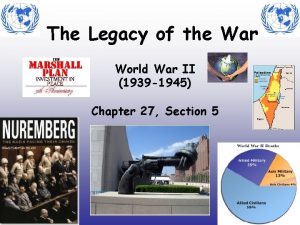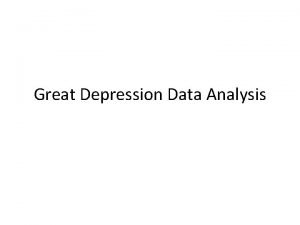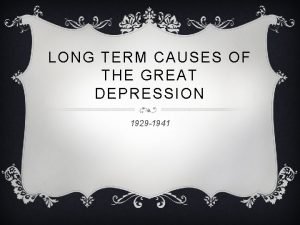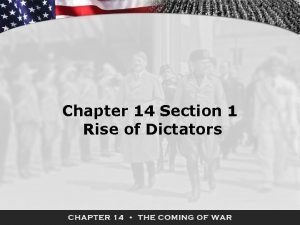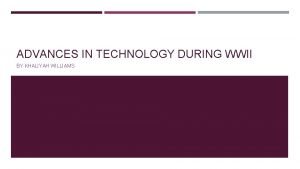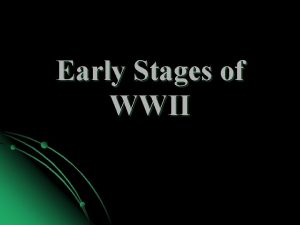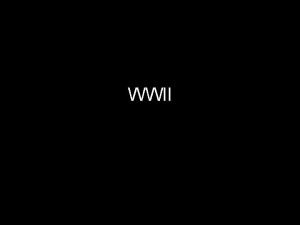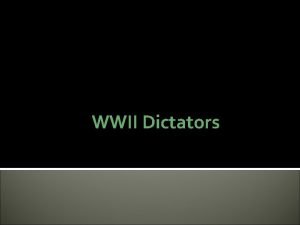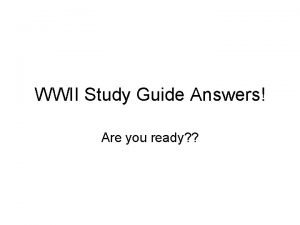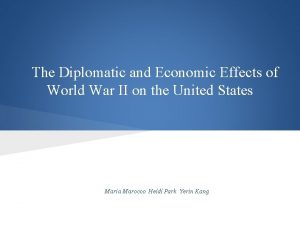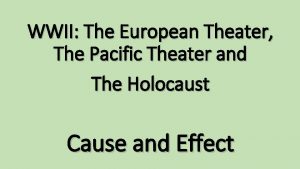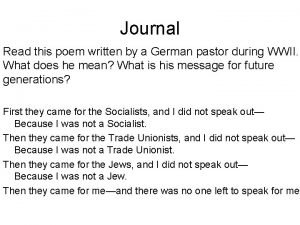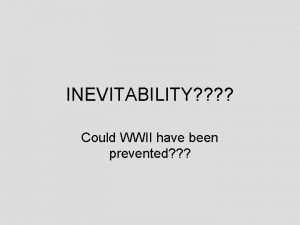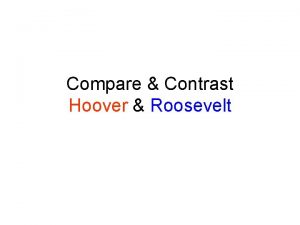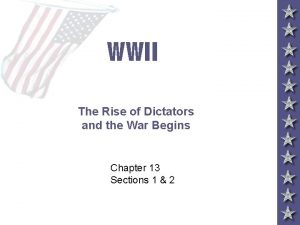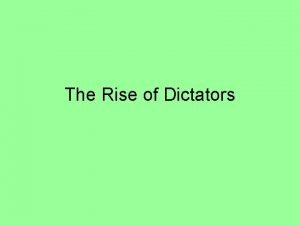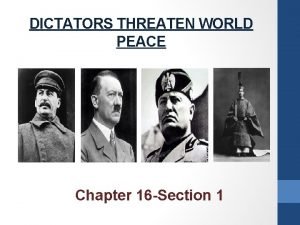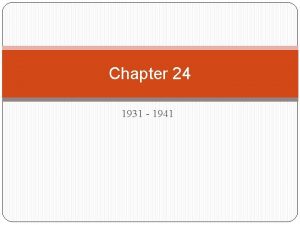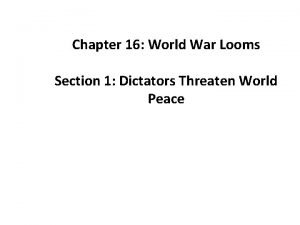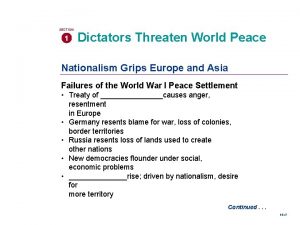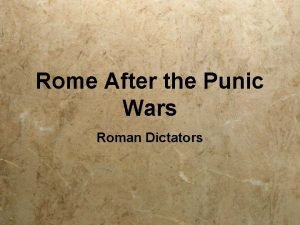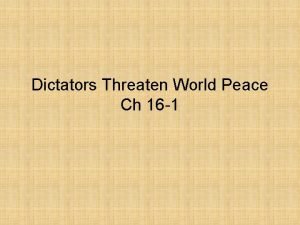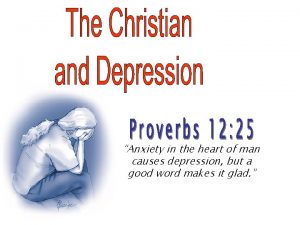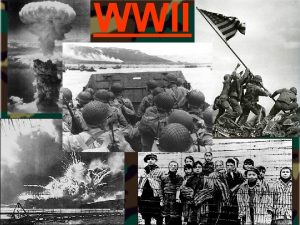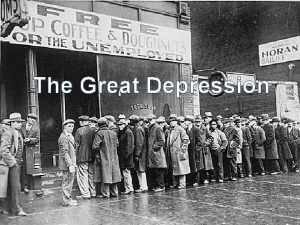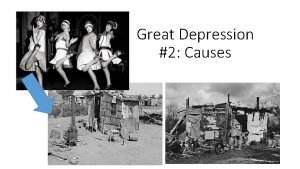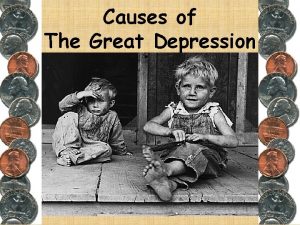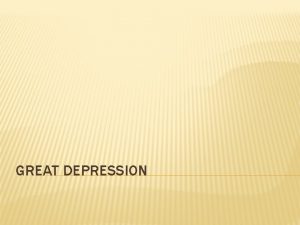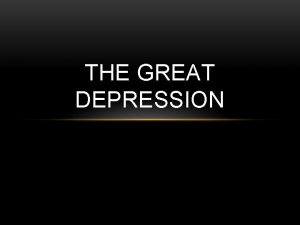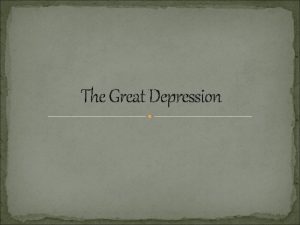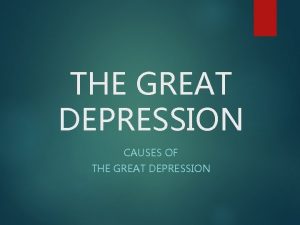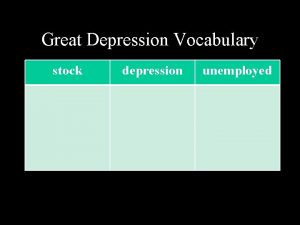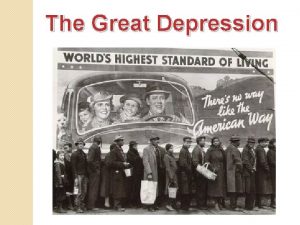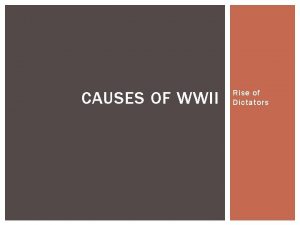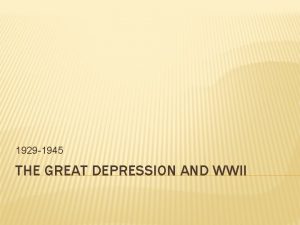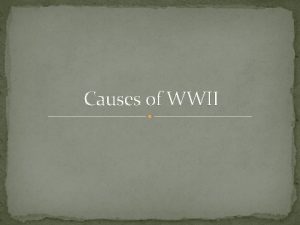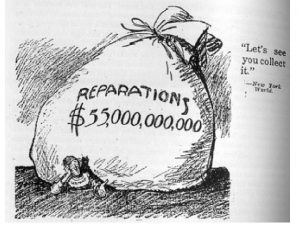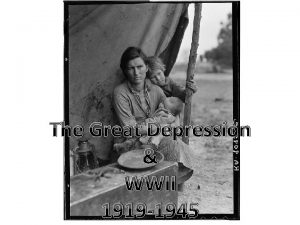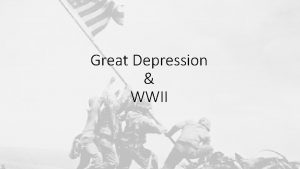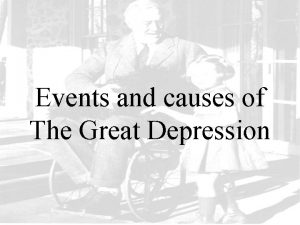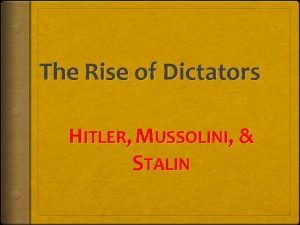Depression Dictators and WWII The Great Depression Causes





























- Slides: 29

Depression, Dictators, and WWII

The Great Depression • Causes • Several long-term problems negatively affected the U. S economy • Companies overproduced consumer goods • Consumers did not have enough money or credit • Farmers overproduced, driving down prices and incomes • The American stock market crash caused enormous financial losses and triggered a global financial crisis • Worried American bankers recalled loans to European banks. Austria’s largest bank failed, starting a financial panic in central Europe • The financial crisis led to sharp declines in global trade and manufacturing • The United States raised protective tariffs, forcing other nations to retaliate • Governments cut budgets and reduced spending, helping to accelerate the downward spiral

• Impact on Europe • Replaced the optimistic spirit of the late 20 s with a growing sense of doubt and fear • Created uncertainty and insecurity for millions of unemployed workers • Prompted increase government economic intervention • Created opportunities for demagogues and dictators to exploit peoples fears European Depression

Conservative Authoritarianism and Totalitarianism • Conservative Authoritarianism • Committed to the existing social order • Opposed to popular participation in government • Revived in eastern Europe, Spain and Portugal • Totalitarianism • Exercised total control over the live of individual citizens • Used modern technology and communication to manipulate and censor information • Used education to mold loyal citizens and demonize scapegoats and enemies

• Forms of Totalitarianism • Fascism • Led by one leader and one party • Condemned democracy, arguing that rival parties undermine national unity • Supported state sponsored capitalism • Glorified war and aggressive nationalism • Exercised control over the media • Communism • Led by one party, “the dictatorship of the proletariat” • Condemned capitalism, it exploits workers • Supported state ownership of the means of production • Glorified the working class • Exercised control over the media

Learning meaning of `isms' until the cows come home By Ann Landers. • Socialism: You have two cows. Give one cow to your neighbor. • Communism: You have two cows. Give both cows to the government, and they may give you some of the milk. • Fascism: You have two cows. You give all of the milk to the government, and the government sells it. • Nazism: You have two cows. The government shoots you and takes both cows. • Anarchism: You have two cows. Keep both of the cows, shoot the government agent and steal another cow. • Capitalism: You have two cows. Sell one cow and buy a bull. • Surrealism: You have two giraffes. The government makes you take harmonica lessons

Lenin, Stalin and Communist Russia 1921 -1929 • Vladimir Lenin and the New Economic Russia • Widespread famine, a deteriorating economy and increasing unrest all plagued Russia following the civil war • Lenin pragmatically realized the he needed to make a tactical retreat. In march 1921, he launched the New Economic Policy. It called for a temporary compromise with capitalism. Small businesses were denationalized and peasants were allowed to establish free markets in agricultural products. The Communist Party still maintained control of large industries such as oil and steel • The New Economic Policy successfully revived the Russian economy. By 1928, the country’s farms and factories produced as much as they had before WWI

• Joseph Leon Stalin versus Leon Trotsky stalin's rise to power - You. Tube • Lenin’s death in 1924 created a power struggle between Trotsky and Stalin • As a charismatic leader since 1905, Trotsky was second only to Lenin in fame. Trotsky believed that Russia should support communist revolutions around the world • In contrast, Stalin was a quiet man who preferred to work behind the scenes. As general secretary of the Communist Party, Stalin placed his supporters in key positions. Stalin argued that communism should first gain a firm hold in Russia before supporting global revolution • Stalin proved to be cunning and ruthless. He successfully expelled Trotsky from the Communist Party. By 1927, Stalin stood alone as the Soviets Union’s undisputed leader

• The Five year Plans USSR Industrialisation and the Five Year Plans under Stalin - You. Tube • In 1928, Stalin launched the first of a series of five year plans designed to transform the Soviet Union’s economic and social structure. The plans had the following goals: • End the New Economic Policy • Create a socialist command economy in which the government makes all economic decisions • Promote the rapid development of heavy industries • Collective agriculture

• Stalin’s commitment to a program of massive, large scale industrialism produced results. By 1940, the Soviet Union was a major industrial power, trailing only the United States and Germany • Stalin’s campaign to collectivize agriculture was less successful. Conservative Russian peasants opposed surrendering their land joining a collective farm. Stalin denounced resisting peasants as kulaks and ordered party members to “liquidate them as a class”. Kulaks and other peasants were executed, starved and deported to forced labor camps.

• The Great Terror • Stalin was a totalitarian dictator who was more powerful than the most autocratic tsar • During the mid 1930 s, Stalin launched a program of statesponsored terror that began with show trials to eliminate Old Bolsheviks. The Great Terror expanded to include intellectuals, army officers, party members and ordinary citizens. • At least 8 million people were arrested. Millions of innocent people died in forced labor camps called gulags.

• Making Comparisons: The Reign of Terror and the Great Terror • The Reign of Terror 1793 -1794 • Ordered by the Committee of Public Safety led by Maximillian Robespierre • Intended to save the revolution from foreign and domestic enemies • Justified by the goal of creating a “republic of virtue” where all citizens would posses high moral standards and be dedicated to the public good • Eliminate political rivals such as Georges-Jacques Danton • Failed to create supporters for Robespierre • Used public executions by the guillotine to terrorize the entire nation • Ended when the Convention reasserted its authority by arresting and executing Robespierre

• The Great Terror • Ordered by Joseph Stalin, general secretary of the Communist Party and dictator of the Soviet union • Purged Old Bolsheviks and other political rivals who threatened Stalin’s power • Justified by claiming the existence of a plot masterminded by Trotsky along with Fascist enemies to overthrow Stalin • Used public show trials, executions and mass imprisonment to terrorize the entire nation • Ended when all rivals to Stalin had been eliminated • Created a new Communist Party staffed with members who demonstrated total loyalty to Stalin

Mussolini and Fascist Italy • Postwar Italy • Italy had entered WWI in hopes of winning mandates in east Africa and Austrian territory along the Adriatic Sea. When the Treaty of Versailles rejected these claims, embittered Italian nationalists felt betrayed • Italy faced a severe economic crisis that included soaring inflation, rising unemployment and massive national debt • Italy’s upper and middle classes feared that the economic crisis and growing labor unrest might lead to a communist revolt

• The Rise of Benito Mussolini: Biography. com • Growing numbers of Italians demanded action and waited impatiently for a strong leader • Mussolini used Italy’s political power vacuum to seize power. As the leader of the Fascist Party, he boldly promised to revive Italy’s economy and rebuild its army. • In 1922, Mussolini called upon his followers to march on Rome. Although the government could have stopped Mussolini with a show of force, King Victor Emmanuel III gave in and named Mussolini prime minister. Why?

• The Fascist State • Mussolini quickly consolidated his power and organized a Fascist state • Mussolini outlawed all political parties except Fascists • Mussolini’s propaganda encouraged Italians to accept his leadership without question. Slogans such as “Mussolini is Always Right” covered billboards across Italy • The Corporate Economy • Mussolini believed that capitalists and workers must be forced to cooperate for the good of the state • He organized 22 state corporations to run all parts of the Italian economy. Each corporation included employers, employees and government arbitrators • The corporations outlawed strikes and set wages and prices • It is important to note that Mussolini's corporate state combined private and state control over economic decisions

• The Lateran Accord • Mussolini successfully negotiated an end to the long dispute between the papacy and the Italian state • Pope Pius XII recognized the legitimacy of the Italian state. In return, Mussolini recognized Vatican City as an independent state ruled by the people A Visit to the Vatican - You. Tube Test Tip: Apeuro tests do not devote as much attention to Mussolini as they do to Adolf Hitler and Stalin. Don’t be distracted by the Black shirts, the March on Rome and Mussolini’s bombastic speeches. Instead focus on the ideology of Fascism and the characteristics of Mussolini’s corporate state

Hitler and Nazi Germany • Reasons why the Weimar republic failed • Many Germans refused to believe that their army had been defeated in battle. They believed instead that the German army had been betrayed by socialist and liberal politicians associated with the new Weimar Republic • The Versailles Treaty outraged nationalists who resented the warguilt clause and the loss of territory to Poland. Constant nationalist agitation undermined support for the Weimar Republic. • Conservatives wanted a strong leader who would restore order and reduce the power of labor unions • Runaway inflation during the early 1920 s destroyed middle-class savings, thus eroding confidence in the government • The Great Depression had a particular devastating impact on Germany. Millions of workers lost faith in the Weimar Rep. • Article 48 of the German constitution helped to undermine the republican government by allowing the president to rule by decree in cases of national emergency. Do we something like Article 48 in our Constitution?

• Reasons why Adolf Hitler rose to power Hitler's Rise to Power • The weakness of the Weimar Rep. helped prepare the public for a bold leader who would restore German Pride • Hitler concluded that he would not attempt to over throw the Weimar Rep. By revolutionary means. Instead, he would use the electoral process to legally gain power (Napoleon used democracy to destroy democracy) • Hitler was a spellbinding demagogue who denounced the Weimar Rep. and the Versailles Treaty. He skillfully used modern propaganda techniques to convince the German people to follow his leadership • Hitler offered the German people an ideology that exploited their fears. The Nazi program included the following key points:

• Nationalism: German national honor would be avenged by regaining the lands taken by the VT • Master race: the Germans were a master race who needed land in eastern Europe and Russia • Anti-Semitism: Jews were an inferior race responsible for many of Germany’s problems (only 600, 000…little resistance, who will notice) • Anticommunism: Marxists were responsible fomenting labor unrest. Much of Hitler’s anti – Semitism focused on alleged Jewish responsibility for the rise of communism • The fuhrer (leader): Parliamentary government produced weak, vacillating politicians. Hitler believed that Germany required an absolute leader or fuhrer who would embody the national will.

• The Nazi totalitarian state • Hitler ruthlessly transformed Germany into a totalitarian state. A series of laws banned all political parties except the Nazis. A special secret police called Gestapo used sweeping powers to arbitrarily arrest anyone who opposed Nazi rule • The Government supervised both labor and business. New laws banned strikes and dissolved independent labor unions. • A ministry of culture supervised the media and shaped public opinion. Special films such as Triumph of Will glorified Hitler’s leadership • It is interesting to note that the Nazi party’s ideal German woman was a mother ( produce the nations off spring), wife (respect her husband) and homemaker

• Anti Semitism • Although Jews comprised less than 1% of Germany’s population, Hitler blamed them for Germany’s problems • In 1933, the Nazi passed laws forbidding Jews to hold public office. Two years later, the Nuremburg Laws deprived Jews of German citizenship and required them to wear a yellow Star of David as identification • Nazi violence against Jews steadily mounted. On November 9 and 10 th 1938, the Nazi organized a spontaneous campaign of mob violence known as Kristallnacht or Crystal Glass. The night of broken glass

The march of Fascist aggression • Hitler and the Versailles Treaty • In 1933, Germany withdrew from the League of Nations • In 1935, Hitler openly began to a program of rearmament • In March 1936, Hitler ordered the German army to march into the demilitarized zone of the Rhineland • Mussolini and Ethiopia • In October 1935, Mussolini ordered a massive invasion of Ethiopia • The invasion represented a crucial test of the League of Nations’ system of collective security • Although the League condemned Italy, its members did nothing. The British and French hoped that appeasing Mussolini would maintain the peace

• Reasons why the democracies failed to act • The Great Depression forced the United States, Great Britain and France to focus on domestic issues • The horrific loss of life in WWI created a deep desire for peace • American isolationists believed that the US involvement in WWI had been a mistake. They wanted to avoid becoming entangled in European affairs • The democracies repeatedly underestimated Hitler’s thirst for power and conquest…revenge! • Does any of this sound familiar? Are we on course to repeat history for failing to learn from it?

• The Spanish civil war (Was this a foreshadowing of WWII? ) • Spain was a deeply dived country. Between 1931 and 1936, a democratically elected government tried to cope with the Great Depression. Led by General Francisco Franco, army leaders supported by the clergy and aristocracy favored a fascist style government • The Spanish Civil War began in 1936 when nationalist forces led by Franco rebelled against the republic • The civil war escalated a into an international ideological war when Hitler and Mussolini sent men and materials to support the Nationalists. The Russians countered by supporting the Republican/loyalist side • During the war, a squadron of German planes bombed the defenseless village of Guernica, killing hundreds of innocent people. Pablo Picasso painted Guernica to protest this atrocity. • Republican resistance finally collapsed in 1939. Franco then established an authoritarian regime that remained in power until his death in 1975. It is important to note that Spain was officially neutral

Picasso’s Guernica

• The Munich conference • In 1938, Hitler successfully annexed Austria into Germany. • Hitler’s campaign of German expansion focused next on a mountainous region of western Czechoslovakia called the Sudetenland. This heavily fortified strategic region contained 3 million German speaking people • Hitler, British Prime Minister Neville Chamberlain, Mussolini and French Premier Edouard Daladier held an emergency conference in Munich to negotiate Hitler's demand that he be given the Sudetenland. • Chamberlain believed he could preserve the peace by appeasing Hitler and giving in to his demands. • The Munich Conference marked a turning point in European history. Filled with confidence, Hitler now made plans to attack Poland. • The Munich Conference quickly became a symbol of surrender. Following WWII, democratic leaders vowed they would never again appease a ruthless dictator. Really? What about Putin?

WWII World War II: Crash Course World History #38 - You. Tube • The outbreak of WWII • In August 1939’ Germany and the Soviet Union stunned the world by announcing a 10 year nonaggression pact. In addition, they secretly agreed to divide eastern Europe. • On September 1, 1939, German forces attacked Poland, two days later, Great Britain and France declared war on Germany. • Germany’s blitzkrieg (lightning) combined fast moving armor and air power to overwhelm Poland • The Holocaust The Final Solution The Holocaust Exclusive Videos & Features - HISTORY. com • The Nazi nightmare did not stop on the battlefields of Europe. Hitler ordered the systematic killing of Jews and other allegedly inferior peoples. This horrible destruction of life is known as the Holocaust. • Such Ignorance about the Holocaust! | Israel Video Network

• The following factors contributed to the Holocaust: • Jews were a small and vulnerable minority • Hitler’s propaganda convinced German’s that Jews were an inferior race that should be eliminated • Hitler’s secret police successfully stifled dissent • The Nazis successfully secured collaborators in occupied territories Test Tip: WWII has generated fewer AP questions than any other major historic event. Although our section on WWII is very brief, it covers the topics that have generated questions. Study Nazi. Soviet Pact, the blitzkrieg and the Holocaust. Ignore battles and generals. .
 Causes of wwii
Causes of wwii Great depression causes
Great depression causes What were the long term causes of the great depression
What were the long term causes of the great depression Chapter 14 section 2 totalitarianism
Chapter 14 section 2 totalitarianism Ww2 phonetic alphabet
Ww2 phonetic alphabet Advances in technology during wwii
Advances in technology during wwii Define nye committee
Define nye committee Wwii picture
Wwii picture Wwii picture
Wwii picture Ww2 study guide answer key
Ww2 study guide answer key Effects world war 2
Effects world war 2 1950s television history
1950s television history 1500 dead in hawaii congress votes war
1500 dead in hawaii congress votes war German aggression map
German aggression map Wwii
Wwii Could wwii have been prevented
Could wwii have been prevented Wwii test review
Wwii test review Apush wwii dbq
Apush wwii dbq Compare and contrast hoover and roosevelt
Compare and contrast hoover and roosevelt Rise of dictators graphic organizer
Rise of dictators graphic organizer Types of dictatorship
Types of dictatorship Chapter 16 section 1 dictators threaten world peace
Chapter 16 section 1 dictators threaten world peace Chapter 24 world war looms
Chapter 24 world war looms Dictators threaten world peace
Dictators threaten world peace Chapter 16 building vocabulary world war looms
Chapter 16 building vocabulary world war looms Dictators threaten world peace
Dictators threaten world peace Rome after the punic wars
Rome after the punic wars Chapter 16 dictators threaten world peace
Chapter 16 dictators threaten world peace Vocabulary review causes of the depression
Vocabulary review causes of the depression Anxiety in the heart of man causes depression
Anxiety in the heart of man causes depression
